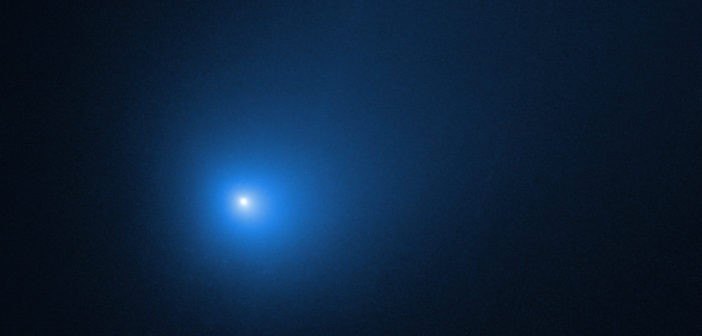What do we know about the second object to visit us from another stellar system? Detailed Hubble images have given us plenty to consider!
Extrasolar Guests Among Us
When asteroid 1I/‘Oumuamua tore through our solar system last year, it was a one-of-a-kind event: the first time we had observed an object from another stellar system pass through our own. But nature likes to keep us on our toes — and it wasn’t long before the next interstellar object paid us a visit.In October of 2019, comet 2I/Borisov was first spotted. The body swung through perihelion — the point closest to the Sun — in December and then sped along on its way back out through our solar system. It’s expected to reach the distance of Jupiter in July of 2020, and the distance of Saturn by March of 2021.
Apples and Oranges, Asteroids and Comets
Our two interstellar visitors thus far, however, are surprisingly dissimilar. Unlike ‘Oumuamua, Borisov doesn’t have an obviously elongated, tumbling shape. And though observations of ‘Oumuamua showed it to be entirely inactive, Borisov has the appearance of a typical solar system comet: it has a prominent coma — a cloud of gas and dust — around it, and its spectrum contains weak lines that demonstrate ongoing outgassing.
As comet Borisov approached perihelion, a team of scientists led by David Jewitt (UC Los Angeles) imaged it with the Hubble Space Telescope, capturing this body at a distance of just 2.4 AU from the Sun. These observations provide us with a stunningly detailed look at an interstellar object.
A Comet Under Scrutiny
What have we learned from these new data?
- Size

Composite Hubble image of comet Borisov taken on 12 October 2019 shows the coma and extensive tail of dust trailing from the comet. The 5” scale bar corresponds to a distance of 10,000 km. [Jewitt et al. 2020]
Jewitt and collaborators use three independent constraints — the comet’s surface brightness, the rate of its acceleration from forces other than gravity, and its gas production — to measure the size of the comet’s nucleus. They show that this body is likely much smaller than originally thought: just 200–500 meters in radius, as opposed to the 2–16 km estimated from initial observations. - Density
The authors show that the above constraints also dictate a minimum density for the comet nucleus of at least 25 kg/m3 (for comparison, Earth’s density is 5,500 kg/m3). This rules out extreme low-density models for this body like some of those proposed to explain ‘Oumuamua’s unexpected acceleration (which have proposed densities of as little as 0.01 kg/m3). - Spin-up
The small radius for Borisov renders this body susceptible to being spun up by torques from asymmetric outgassing. Jewitt and collaborators show that in the ~0.6 years Borisov will spend heating up within 3 AU of the Sun — and, consequently, outgassing as its water sublimates — the spin of the comet could change significantly, perhaps even causing the body to break up entirely! We can keep an eye out for spin changes as we observe it in the future.
There’s still plenty to learn as we continue to track this newest interstellar object — and we can surely expect more visitors to drop in for future observations!
Citation
“The Nucleus of Interstellar Comet 2I/Borisov,” David Jewitt et al 2020 ApJL 888 L23. doi:10.3847/2041-8213/ab621b



5 Comments
Pingback: ESTUDO DETALHADO DO COMETA INTERESTELAR 2I/BORISOV | SPACE TODAY TV EP2115 - Fácil Saber - Conhecimento Online
Pingback: ボリソフ彗星、当初の予想ほど大きくはなかった - sorae 宇宙へのポータルサイト
Pingback: SPACE TODAY
Pingback: ESTUDO DETALHADO DO COMETA INTERESTELAR 2I/BORISOV | SPACE TODAY TV EP2115 | Mestre Jedi
Pingback: Allgemeines Live-Blog ab dem 14. März 2020 | Skyweek Zwei Punkt Null